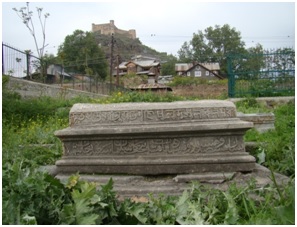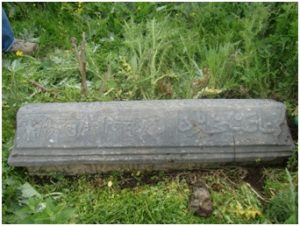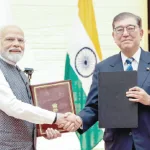This ancient graveyard is also known as mazaari sulateen and it is believed that it has been the first Muslim cemetery built by sultan Zain ul Abi udin
Mazari Qalan, popularly known to public as “Mazari Shiekh Bahau-ud-Din Ganj Baksh (RA)” lies in the feets of Kohi Maran to the west of Malkah. The history of the Mazar reveals that the site originally was proposed by Zain-ul-Abidine Badshah in 1421 AD for housing the only burial of his beloved wife called Ashama Bibi who belonged to a noble family of Bahaqi Sect. But when Sheikh Baha-ud-Din (RA), the reputed saint and peer Mursheed of the Sultan left for heavenly aboard in December 11, 1439 AD, he was laid to rest in this proposed site and over the resting-place a magnificent shrine symbolizing the reshi order architecture was also then erected.
This ancient graveyard is also known as mazaari sulateen and it is believed that it has been the first Muslim cemetery built by sultan Zain ul Abi udin. It served the final resting place of nobles of sultanate period and their tombs carry magnificent Persian and Arabic epigraphs. Adjacent to the shrine is seen the grave of the poet, Mir Illahi, who is said, was the court poet of the Badshah. A beautiful inscription bearing few lines of his lyric is erected over the grave. The grave of Asaha Bibi lies near the gate of the Mazar. The other burials it houses of the reputed saints and nobles of their times include; the grave of Solman, Sayyied Habib Shah Kashani, Moullana Mohammed Anie, Baba Qayim, Khwaja Mohammed Kakroo, Moullana Mohammed Balkhji, Sheikh Mohammed Trabali, Mulla Sarf-ud-Din Farhat, Mulla Nurullah Kath, Molvi Amir-ud-Din, Molvi Qulam-ud-Din Jami, Sayyied Mohammed Kermani and others. These all graves are very old and are crowned with gravestones, which are brilliancy carved in beautiful Arabic and Persian inscriptions.
A grave of some unknown personality lies near the Shrine of Baha-ud-Din. The grave is of Badshah’s times and carries a large beautiful Arabic inscription in Salus style of writing. But most interesting inscriptions are encountered on few tomb stones in the deep of this historic mazaar. Those inscriptions are trilingual, in sharda, Persian and Arabic which speaks about its cultural integrity. There we see the three scripts, Sanskrit, Persian and Arabic meeting together. These are the earliest tomb stones of this ancient graveyard and represent the age when the ancient script sharda and Sanskrit had been still very much popular, side by side with Arabic and Persian languages. Since the sharda alphabet and Sanskrit had been exclusively used during pre Muslim times and with the establishment of Muslim kingdom, the sharda and Sanskrit was taken over by the Persian and Arabic alphabet, but it does not mean that the scripts of the pre Muslims times were absolutely discontinued. The sharda alphabet and Sanskrit had been still in usage at that time. Obviously it may have lost its official patronage, but in the pundit patshalas the script had been taught and learned till late nineties. In fact the Muslim tomb stones depicting legends in sharda and Sanskrit language and alphabet is a physical evidence of its usage in Muslim traditions as well.
There are still few such tomb stones found in this historic graveyard which besides Persian and Arabic inscriptions have carried inscriptions in sharda and Sanskrit. Although most of the tomb stones of this graveyard are still unidentified, but one of the tomb stone bearing trilingual inscriptions has been identified. The grave is of one Sayyid Khan, who is recorded in the inscriptions that he was killed in 789 AH (1387 AD) on the Kohi Suliman, more popularily known these days as Shankeracharya hill.

Trilingual tomb stone inscription, persain, sharda and Arabic, Mazari qalan srinager

Bilingual, tomb stone inscription sharda and persain Mazari qalan srinager
Furthermore, all the other tomb stones are unidentified. Most of the tomb stones of other historic mazaars carrying magnificent Persian and Arabic legends are quite unpreserved, It has been observed that at several sites, which included the ancient royal graveyards ( Mazaari Sulateen) of old srinager, Baramullah, Sopore , Avantipura, Pompur , Bijbehera, and Anantnag this heritage has been facing the challenges of weathering and human vandalism and number of epigraphs on the open tomb stones and rocks have defaced and there writings have become quite illegible. Number of inscriptions has gathered rust, which not only affect the aesthetics of the stones but shall also lead to long term damage if left unattended. As such if the requisite and necessary conservation steps are not taken up at an earliest, the human records scattered in the ancient graveyards would disappear forever. The few tomb stones carrying bilingual and trilingual inscriptions are facing the same threat.
The state Archaeology department, Academy of Art, Culture and languages and Persain and Sanskrit departments of Jammu and Kashmir universities shall come forward and identify the areas of this heritage and document and preserve it for the generations to come.
(Author is a Senior Archaeologist and can be reached at: [email protected])








